Atimos® Modulite® pMDI
Your doctor, nurse or pharmacist has prescribed an Atimos pMDI to help you to manage your asthma or COPD.
‘pMDI’ stands for ‘pressurised metered dose inhaler’, and your prescribed inhaler should look like the image here.
Taking your inhaler as prescribed can help to manage your symptoms, and this page contains information to help you with this. Remember, should you need additional advice regarding your asthma, please speak to your doctor, nurse or pharmacist.
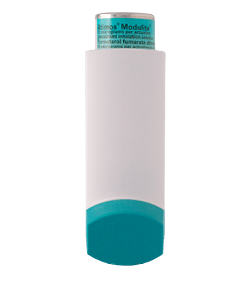
Your inhaler contains a type of medicine called a long-acting bronchodilator (formoterol) that helps to open up the airways to make breathing easier.
How to use Atimos
How to use AtimosAtimos Patient Information Leaflet
Atimos Patient Information LeafletAtimos for asthma
The dose of Atimos you must inhale will depend on the type of asthma you have and how severe it is. Your dose will be decided by your doctor and it is important that you only take the prescribed dose, regularly.
The usual dose for adults, including the elderly and adolescents 12 years and older is:
- 1 puff in the morning
- 1 puff in the evening
This means you need to take a total of 2 puffs (24 micrograms) of Atimos per day.
If you suffer from more severe asthma, your doctor may prescribe 2 puffs in the morning and 2 puffs in the evening: 4 puffs per day (48 micrograms).
4 puffs (48 micrograms) of Atimos is the maximum daily dose and it is important that you do not take more than the total daily dose that your doctor has told you to take.
This product is not suitable for patients with asthma under 12 years old.
Atimos for COPD
The usual dose for adults including the elderly and adolescents 18 years and older is:
- 1 puff in the morning
- 1 puff in the evening
This means you need to take a total of 2 puffs (24 micrograms) of Atimos per day.
If you suffer from more severe COPD, your doctor may prescribe 4 puffs per day (48 micrograms), 2 puffs in the morning and 2 puffs in the evening.
4 puffs (48 micrograms) of Atimos is the maximum daily dose and it is important that you do not take more than the total daily dose that your doctor has told you to take. Do not take more than 2 puffs at any one time.
This product is not suitable for patients with COPD under 18 years old.
First use
Before use
Before using your inhaler for the first time, or if it’s not been used for 3 days or more, prime your inhaler by releasing 1 puff into the air to make sure it is working properly.
You should see a ‘mist’ come from your inhaler. Whenever possible, sit or stand in an upright position when using your inhaler.
Everyday use
To use your Atimos inhaler follow the 5 steps shown here. Do not rush yourself.
-
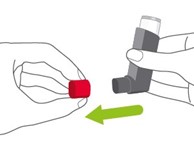
Step 1
Remove the mouthpiece cover from the inhaler and hold it between the thumb and forefinger as shown.

Step 2
Breathe out as far as is comfortable.
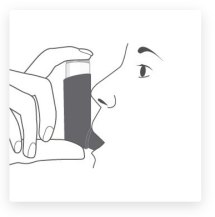
Step 3
Hold the inhaler upright between the thumb and forefinger with your thumb on the base below the mouthpiece. Place the mouthpiece in your mouth between your teeth and close tightly your lips around it.
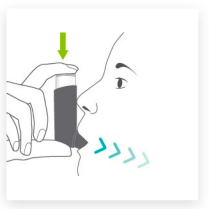
Step 4
Breathe in slowly and deeply through your mouth and at the same time press down on the top of the inhaler to release a puff.
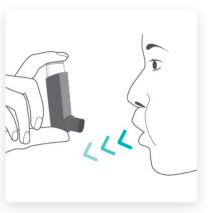
Step 5
Hold your breath as long as is comfortable, then take the inhaler from your mouth.
If you are to take another puff, keep the inhaler upright and wait about half a minute before repeating steps 2 to 5.
Do not repeat steps 2 to 5 too quickly. This medicine may take 1-3 minutes to work.
After use
After use, close your inhaler again with the mouthpiece cover.
To lower the risk of a fungal infection in your mouth and throat, rinse your mouth or gargle with water, without swallowing, or brush your teeth each time after you use your inhaler.
How to use Atimos
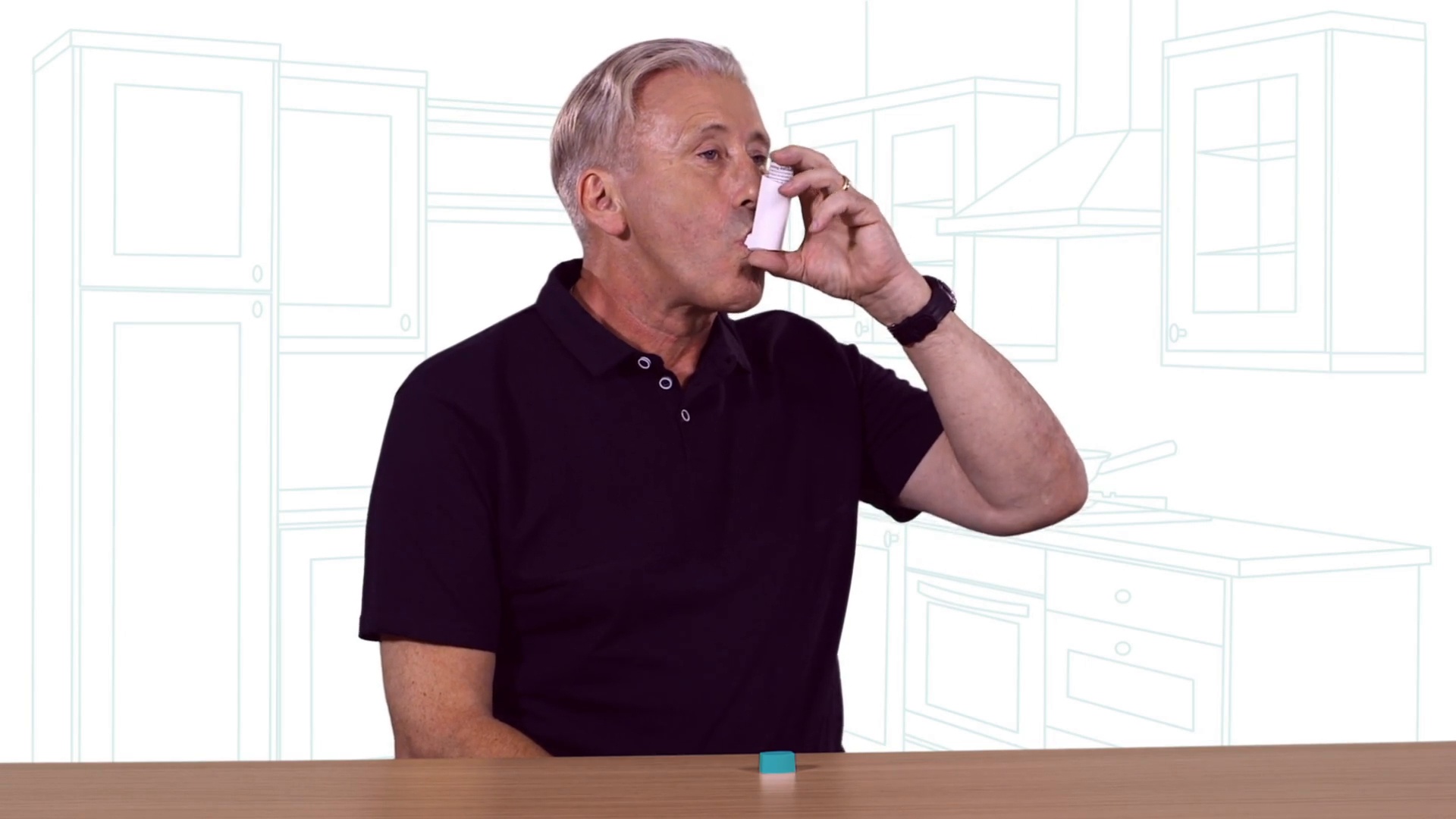
Disposal
Medicines should not be disposed of via waste water or household waste. Ask your pharmacist how to dispose of medicines no longer required. These measures will help to protect the environment.
Frequently Asked Questions
Using your inhaler
-
Do not use Atimos to treat a sudden attack of breathlessness. You should use a ‘reliever’ inhaler prescribed by your doctor, nurse or pharmacist for this purpose, carry this medicine with you at all times.
-
Understandably, when you don’t have any symptoms, it can be easy to forget to take your treatment or to feel like you do not need to. You must use your inhaler every day, even when you are feeling well. Regular use of your inhaler is the most effective way to keep you feeling this way.
Looking after your inhaler
-
Do not use Atimos beyond 3 months from the date you get the inhaler from your pharmacist and never use after the expiry date which is stated on the carton and label. The expiry date refers to the last day of that month.
- Do not store the inhaler above 30o
- If the inhaler gets very cold, take the metal canister out of the plastic case and warm it in your hands for a few minutes before use. Never use anything else to warm it up
- Do not pierce the pressurised container.
-
It is important to clean your inhaler regularly, at least once or twice a week to ensure that it works properly.
To clean your inhaler:
- Pull the metal canister out of the plastic case of the inhaler and remove the mouthpiece cover
- Rinse the plastic case and the mouthpiece cover in warm water
- Do not put the metal canister into water
- Leave to dry thoroughly in a warm place. Avoid excessive heat
- Replace the canister and mouthpiece cover
Side effects and other medications
-
Like all medicines, Atimos may cause side effects, although not everybody gets them. If you do get any side effects, talk to your doctor, pharmacist or nurse. This includes any possible side effects not listed in the Patient Information Leaflet.
You can also report side effects directly via the Yellow Card Scheme. By reporting side effects you help provide more information on the safety of this medicine.
-
Your doctor, nurse or pharmacist can advise you about using other prescribed medications. You should also check with your pharmacist before taking medicines bought over the counter.
You must tell your doctor, nurse or pharmacist about any medication you may be taking, including herbal remedies.
It can be isolating, suffering from a condition that may limit your ability to get out and about. There is a lot of information available online, but it’s important to go to a reliable source. The suggested resources listed below can offer you further support on the various aspects of living with COPD or asthma.
NHS
Helpline: 111 (non-emergency)
NHS asthma information
NHS COPD information
NHS Smokefree
Asthma + Lung UK
Helpline: 0300 222 5800 (non-emergency)
Explore support for asthma
Explore support for COPD
The information provided here is not intended to replace the advice of your healthcare professional. If you have any questions about your medication, please speak to your doctor, nurse or pharmacist.
If you have not been prescribed Atimos and are looking for information on another Chiesi respiratory product please visit our homepage.
Reporting of side effects: If you get any side effects, talk to your doctor, pharmacist or nurse. This includes any possible side effects not listed in the package leaflet. You can also report side effects directly via the Yellow Card Scheme at: www.mhra.gov.uk/yellowcard. By reporting side effects you can help provide more information on the safety of this medicine.

